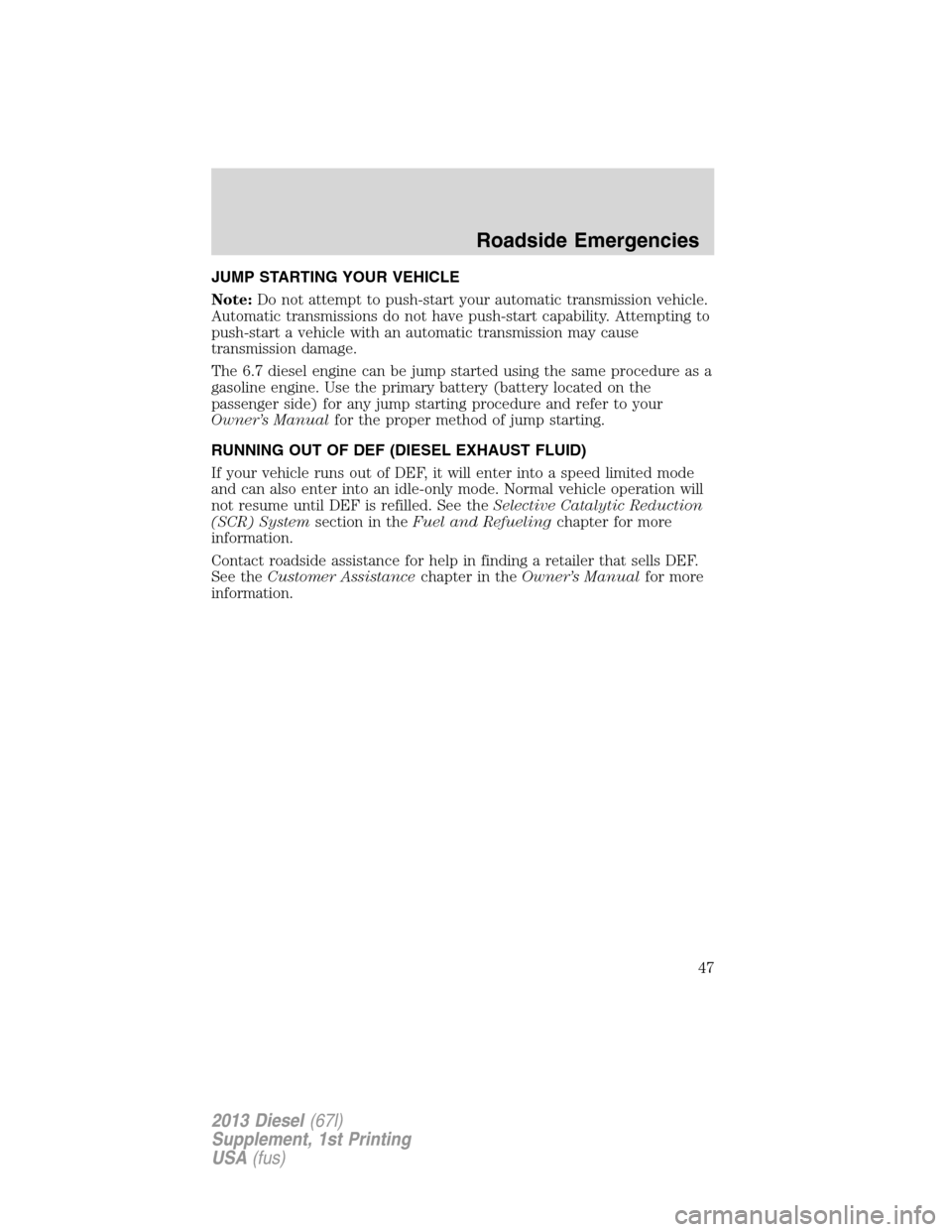Page 3 of 95

POWER STROKE DIESEL ENGINE
Note:Your vehicle’s powertrain control systems can detect and store
information about vehicle modifications that increase horsepower and
torque output such as whether or not performance-enhancing powertrain
components commonly referred to as “performance chips” have been
used. This information cannot be erased and will stay in the system’s
memory even if the modification is removed. The information can be
retrieved by Ford Motor Company, Ford of Canada, and service and
repair facilities when servicing your vehicle. This information may be
used to determine if repairs will be covered by warranty.
Note:Some aftermarket products may cause severe engine/transmission
and/or exhaust system damage; refer to your warranty information for
more information.
Your new diesel engine will feel, drive and function somewhat differently
than a gasoline engine. Therefore it is very important that you read and
thoroughly familiarize yourself and others operating the vehicle with this
guide. A special procedure for turning off the diesel engine is in the
Starting and Stopping the Enginechapter.It is important to read
and understand this material in order to maintain the best
service life for your engine.
This supplement will acquaint you with the Power Stroke diesel engine.
It provides recommendations on engine care and operating procedures.
For complete vehicle information, also refer to yourOwner’s Manual
included with the vehicle. It also describes equipment and gives
specifications for equipment that was in effect when this guide was
approved for printing, and should be considered a permanent part of the
vehicle.
Ford may discontinue models or change specifications without any notice
and without incurring obligations.
WARNINGS
Throughout this guide, you will find warnings identified by the warning
symbol. Warnings remind you to be especially careful to reduce the risk
of personal injury.
Introduction
2
2013 Diesel(67l)
Supplement, 1st Printing
USA(fus)
Page 45 of 95
INTEGRATED ENGINE BRAKING
This feature increases engine braking at higher engine speeds to provide
better grade descent control with less brake and transmission wear and
tear.
This feature is integrated with the tow/haul mode feature. When tow/haul
mode is switched on, the integrated engine braking feature will also be
active. For more information on tow/haul, seeAutomatic transmission
operationin theOwner Manual.
Brakes
44
2013 Diesel(67l)
Supplement, 1st Printing
USA(fus)
Page 48 of 95

JUMP STARTING YOUR VEHICLE
Note:Do not attempt to push-start your automatic transmission vehicle.
Automatic transmissions do not have push-start capability. Attempting to
push-start a vehicle with an automatic transmission may cause
transmission damage.
The 6.7 diesel engine can be jump started using the same procedure as a
gasoline engine. Use the primary battery (battery located on the
passenger side) for any jump starting procedure and refer to your
Owner’s Manualfor the proper method of jump starting.
RUNNING OUT OF DEF (DIESEL EXHAUST FLUID)
If your vehicle runs out of DEF, it will enter into a speed limited mode
and can also enter into an idle-only mode. Normal vehicle operation will
not resume until DEF is refilled. See theSelective Catalytic Reduction
(SCR) Systemsection in theFuel and Refuelingchapter for more
information.
Contact roadside assistance for help in finding a retailer that sells DEF.
See theCustomer Assistancechapter in theOwner’s Manualfor more
information.
Roadside Emergencies
47
2013 Diesel(67l)
Supplement, 1st Printing
USA(fus)
Page 70 of 95
Item Capacity Ford part nameFord part number /
Ford specification or
specification
Fuel tank — Dual
tanks40 gallon (151.4L)
and
28 gallon (106.0L)——
Automatic transmission
fluidRefer toOwner’s Manual
* Use only the recommended coolant for topping off and coolant changes. Using any other coolant
may result in vehicle damage.
Capacities and Specifications
69
2013 Diesel(67l)
Supplement, 1st Printing
USA(fus)
Page 77 of 95

Normal Scheduled Maintenance1
At every oil change
interval as indicated
by the information
displayChange engine oil and filter.2
Refill diesel exhaust fluid tank.
Rotate tires3, inspect tire wear and measure tread
depth.
Perform multi-point inspection (recommended).
Inspect air filter restriction gauge. Replace filter if
necessary.
Inspect automatic transmission fluid level.
Inspect brake pads, shoes, rotors, drums, brake
linings, hoses and parking brake.
Inspect engine and secondary coolant level and
hoses.
Inspect exhaust system and heat shields.
Inspect front axle and U-joints. Lubricate if equipped
with grease fittings (4WD vehicles).
Inspect steering linkage, ball joints, suspension,
tie-rod ends, driveshaft and U-joints. Lubricate if
equipped with grease fittings.
Inspect wheels and related components for abnormal
noise, wear, looseness or drag.
1Do not exceed one year or 10000 miles (16000 kilometers) between
service intervals.
2Reset your Intelligent Oil-Life Monitor® after each engine oil and filter
change. See theInformation Displaychapter of yourOwner’s Manual.
3Vehicles equipped with dual rear wheels should rotate the front wheels
when specified; rear wheels only if unusual wear is noted.
Additional Maintenance Items1
Every 15000 miles
(24000 km)Inspect engine and secondary cooling system
concentration (freeze-point protection), additive
(corrosion inhibitor) strength, coolant level and
hoses.
2
Every 22500 miles
(36000 km)Replace engine- and frame-mounted fuel filters.3
Scheduled Maintenance
76
2013 Diesel(67l)
Supplement, 1st Printing
USA(fus)